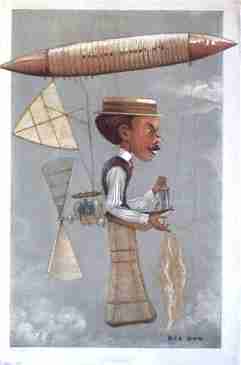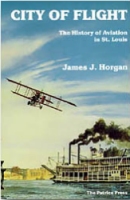
Santos-Dumont
The Deutsch Prize
1901
Geo.Ham
Photo Courtesy of
The Vanity Fair Print Company
1898-1901 |
 |
Santos-Dumont The Deutsch Prize 1901 Geo.Ham Photo Courtesy of The Vanity Fair Print Company |
|
1898-1901 Balloons No. 1 thru No. 5 Balloon No. 6 Balloons No. 7 and No. 9 Editor's Note: These images come from Rod Filan's Ro§bud's WWI Aviation Image Archive. This outstanding resource now contains some 2342 images. The images of the Santos-Dumont balloons are found in a special section which was provided by Jean-Pierre Lauwers. In addition to the 31 images of Santo-Dumont's balloons, it contains some 184 other images of balloons of the period. For anyone interested in the subject, it is absolutely priceless.To access that specific archive, click on: |
|
extract from James J. Horgan's CITY OF FLIGHT III The Lousiana Purchase Exposition, 1904 Primitive efforts continued spasmodically throughout the second half of the nineteenth century until a brilliant young Brazilian, Alberto Santos-Dumont, became :"the first to build and fly an airship in controlled, sustained flight." He ascended in his airship Number 1 from the Zoological Gardens in Paris on September 20, 1898, and rose to 1,500 feet in an impressive flight over the city. In October 1901, Santos-Dumont again stunned Paris when he won the coveted Deutsch Prize of $20,000 for a round-trip flight of seven miles from St. Cloud to the Eiffel Tower within thirty minutes. After seven failures in six different airships, he piloted his Number 6 around the course in 29 minutes and 30 seconds, averaging 14 1/2 miles per hour. When he came to St. Louis in 1904, there was universal expectation that he would be the outstanding aviator at the fair. |
 |
|
|
|
extract from James J. Horgan's CITY OF FLIGHT III The Lousiana Purchase Exposition, 1904 The young South American, whose exploits were legendary, had built his Number 7 airship in 1903 with the specific intention of winning the grand prize of $100,000 with it. This racer was 164 feet long, 26 1/4 feet in diameter, and had a capacity o 44,500 cubic feet of hydrogen. It was powered by a sixty-horsepower Clement engine, driving two 16 1/2 -foot propellers -- one at the bow and the other at the stern of the frame. He was undoubtedly the man to beat, particularly in view of his past successes. On May 16, 1904, however, the Exposition Committee on Aeronautics was thrown into consternation when Santos-Dumont cabled from Paris: Lost sixty horse power engine. Only able to get forty. Airship tried yesterday. Only goes less than twenty miles (per hour). Cannot race until speed condition is cut down to fifteen miles per hour. The exposition officials hardly wanted to lose their star performer, so after a hasty conference, Transportation chief Willard Smith sent Santos-Dumont their answer: Rules changed. Prize of $50,000 is to be awarded if a speed of fifteen miles an hour is attained; $75,000 if of eighteen miles; $100,000 if of twenty miles. The fifteen-mile prize will be $69,000, if the flight is effected in June. As an added inducement to the entrants, the management of the fair offered a bonus of $10,000 above the standing prizes if any contestant performed a successful flight at either of these three speeds before July 1. Unless a minimum of fifteen miles per hour were attained, however, no prize would be awarded at any time. Santos-Dumont arrived in New York on June 17, 1904, with his three assistants: Chapin, Gerome, and André, and on June 23 he was in St. Louis. His first action was to try to persuade fair officials to alter the proposed course for the grand prize trials. He preferred a straightaway ten-mile route with only one turn, while existing rules had set a triangular course, with two, time-consuming turns. The managers again acceeded to his wishes and scheduled his first trial for July 4. He had no time to capture the bonus money with a June flight, since it would take almost a week to assemble his ship. Number 7 arrived by rail from New York on June 26 in three large eighteen foot cases, each weighing 4,000 pounds. The following day, Santos-Dumont directed the opening and inspection of the boxes in the presence of United States Customs officers. The hydrogen bag was made of two layers of silk cemented together, with two coats of varnish on the inside and five on the outside to make it airtight. The Brazilian intended to give it an aditional coat before his trials. "It was found to be in perfect condition after the long trip from Paris." That night, "against the advice of the superintendent of aeronautics," Santos-Dumont left the cover off the crate to let the air curculate around the envelope. At 7:00 a.m. the next day, June 28, one of the French mechanics discovered four, yard-long slashes in the gas bag. The envelope had been folded and the knife had penetrated through three pleats, making twelve rents in all. A single guard had been posted in two shifts during the night. J.H. Peterson had been on duty from dusk until midnignt, when he was relieved by Lucian T. Gilliam. Under questioning, Gilliam revealed that he had been absent twice during the night for short periods for cups of coffee. Police arrested, and later released, Charles F. Meyers of Warren, Massachusetts, who had been found loitering in the area, and the Exposition Company offered a reward of $1,000 for the culprit. This was the third time that the Brazilian had suffered such a mishap. On May 27, his Number 6 had been found slashed to ribbons in London, following a similar occurrence earlier that year. Santos-Dumont was understandable indignant, but he merely expressed the view that it was the work of some vandal and left for Paris July 1 without cooperating with the police or pressing the investigation. He had told exposition officials that he would repair his ship and return by September, but on July 14, 1904, he told a London reporter at Le Havre that he did not intend to return to St. Louis: I never felt so angry and disappointed in myu life. It ouwld have taken at least two months to repair the damage, which means a loss of $8,000. I am of the opinion that the airship was wrecked by a crank and not by one of my rivals. Many theories were advanced to explain the mysterious destruction of the Number 7. Some felt it was the work of a vandal or a jealous rifal, while among the Jefrferson Guards at the exposition the rumor was prevalent that Santos-Dumont himself had slashed the envelope because he feared that he would fail in the severe trials and wished to save face. It must be remembered, however, that the Brazilian airman had played a major role in formulating the rules for the contest, and that he later even succeeded in having the minimum speed lowered to a more manageable fifteen miles per hour. A more scientific view was expressed by Wilfred de Fontvielle, who held that "the salt air encountered in crossing the ocean destroyed the elasticity of the silk and caused it to cut when unfolded." This hypothesis, however, does not seem to take into condideration the nature of the rents involved and the fact that the envelope ws found in perfect condition when it was inspected the day before its destruction. |

City of Flight : The History of Aviation... The History of Aviation in St. Louis by James J. Horgan The Patrice Press. |


|